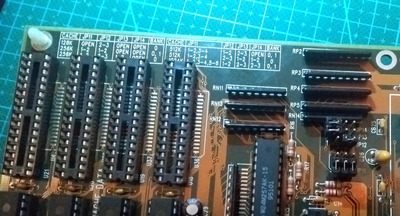350606 wrote on 2020-02-01, 16:52:
Hi! According to some handwritten notes on a manual for a different board, using the AMD Enhanced 486 DX4 should be correct. And, your speaker should be working normally, from the data you gave, by connecting it as usual. But, the manual says that the only recorded beep code is graphics failure, so if something else is failing it might not beep.
Good to know about the settings (edit: and that handwritten note is a nice find!). Weird that the error beeping was so different between boards back then. My other 486 motherboard also has an Award BIOS and does beep if something's up with the memory. But this gives me some more more hope that it isn't dead.
Now, on to the useful part: Looking at your pictures I see only Bank 0 of the cache is populated. Looking at your cache settings jumpers (JP11-14) you seem to have some undocumented configuration. It could just be that I can't see the jumpers correctly, but check it. Pins 1 or 1 and 2 of the jumpers are marked on the board, so you can configure it based on the manual or the text next to the cache chips on your board. EDIT: Just in case, before changing any jumpers, document what you had!
Please, keep us posted on updates!
Interesting observation. I haven't touched them at all since I got the board, assuming that it was fine (but you know what they say about assumptions). I will check the settings and let you know 😀
What I did find surprising is that the cache chips don't take up the entire socket. I found some other random photos online where that was also the case, but does the way they're inserted make sense?
In the overview photo that I posted, the notch on the chips, and marking on the board, are positioned on the left side. The chips are aligned to the right on the socket, leaving a gap on the left. Should they be like this, or be moved to the left side? (I believe there are traces going to all holes so that doesn't give a hint)
Thanks for the help so far everyone!
Am486 DX4 120MHz, no L2, 16MB, Tseng ET4000/W32 1MB VLB, ESS ES1869 /// 5x86 133MHz, 256kb L2, 64MB, S3 Virge/DX 4MB PCI, SB16 + Yucatan FX, PicoGUS /// Pentium III 1GHz, 512MB, Asus V7700 64MB AGP, SB Live!
